 Teacher in Vanuatu.
Teacher in Vanuatu.
The evidence is clear: effective teacher professional development (TPD) needs to include ongoing and individualized support to teachers in order to impact teachers’ instruction, and subsequently student learning. However, what is less clear are the details of what ongoing support entails at the system level: What should be the ratio of pedagogical leaders to teachers? How frequently should pedagogical leaders visit teachers? How long should observation and feedback sessions be?
To answer these questions, the World Bank’s Coach program has developed the “Structuring Effective 1-1 Support Technical Guidance Note,” which provides explicit advice on how to structure the delivery of ongoing support to teachers along a spectrum, which varies depending on the pedagogical leaders’ level of expertise and the support provided to them.
Based on an analysis of 10 high-impact coaching programs in low- and middle-income countries, here are 8 tips to help policymakers structure an effective one-on-one support system:
- Determine whether the system would benefit most from a ‘highly structured” support model or a “low structured” support model. The key difference between these models is the capacity of pedagogical leaders in the system. A highly structured support model entails the use of more structured teaching and coaching materials, in which pedagogical leaders have limited expertise. A low structured support model, in contrast, relies on pedagogical leaders who demonstrate deep expertise in relevant pedagogical and content knowledge.
- Regardless of the support model, ensure pedagogical leaders do not simultaneously support teachers and act as their evaluators. Theory and case-study analyses suggest that having the same individual support and evaluate teachers can both undermine trust and overwhelm the individuals who are expected to take on both roles.
- Ensure pedagogical leaders are not responsible for too many teachers. Teacher-pedagogical leader ratios as high as 44:1 are typical for highly structured support models, whereas, teacher-pedagogical leader ratios of 11:1 are typical for low structured support models.
- Ensure pedagogical leaders are visiting teachers at least once per month and for the duration of the school year. Sustained duration is associated with stronger impacts on teacher practice and student learning because teachers have more opportunities to refine and apply their new practices in their classrooms. Here, it’s important to caveat: a high frequency of visits will be effective only if the quality of support is high.
- When conducting classroom observations, ensure pedagogical leaders use a classroom observation tool and observe teachers for the full duration of the lesson. This full-lesson observation enables the pedagogical leaders to understand the specific practices for which teachers need support at different points in each lesson. Moreover, the use of a classroom observation tool creates a common vision of what effective instruction entails.
- Ensure pedagogical leaders provide feedback to teachers following an observation. Following an observation, it’s crucial for pedagogical leaders to provide tailored feedback to teachers. Feedback sessions range from 20 minutes for highly structured programs to 30 minutes for low structured programs.
- If in-person support is not possible, encourage pedagogical leaders to provide feedback and encouragement through a hybrid model of virtual and on-site support. This format enables the pedagogical leaders to visit the teachers more frequently (at least twice a month). Importantly, remote support interventions require appropriate accountability and support enabled by in-person contact and digital resources, such as high-speed broadband and digital devices, in order to be effective.
- Programs that focus on providing ongoing support to teachers must be embedded within a larger system infrastructure focused on supporting, motivating, and developing teachers throughout their full career cycle. First, ongoing support should be provided as part of a broader program of in-service teacher training. Second, the system should be centered on a vision of instructional coherence, where all components are aligned with improving teaching and learning for all. Lastly, and arguably most importantly, governments must be committed to embed ongoing support in their system.
We have undergone a rigorous process to develop the “Structuring Effective 1-1 Support Technical Guidance Note,” which has included reviewing the literature and consulting with expert researchers and practitioners. We would now like to share the Guidance Note for public consultation, to ensure that we incorporate as broad a range of perspectives and voices as possible. Thus, we are seeking robust and thoughtful comments to ensure that Guidance Note’s content is clear and useful for policymakers and other stakeholders. Please reach out to us at coach@worldbank.org to share your feedback by March 31st 2021, and stay tuned for more opportunities to engage with our work!
Further reading:
• For more on the Coach program, “What can education systems learn from football?”
• For more on how the Coach program fits within the World Bank’s teachers’ strategy, “Realizing the promise of effective teachers for every child – a global platform for successful teachers”
• For more on the World Bank’s teachers’ strategy, “Successful Teachers, Successful Students: Recruiting and Supporting Society’s Most Crucial Profession”



Join the Conversation